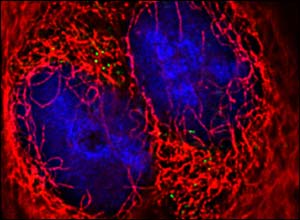
HIV spotted inside human cell
BBC News - Friday, 13 December, 2002

Remarkable time-lapse pictures show, for the first time ever, HIV at work in a human cell.
The pictures offer proof that the virus uses the cell's own machinery to be dragged inside the cell.
An estimated 45 million people worldwide are living with HIV, according to the latest figures.
Scientists are learning more about how HIV causes damage once inside the cell, but, until very recently, very little was understood about how the virus gets in.
The study, by the University of Illinois at Chicago, reveals how HIV "hitches a ride" aboard a cell protein called dynein as it makes it way up tiny microtubules into the cell itself.
The tubules lead all the way to the cell's nucleus, where the virus can begin to start replicating by harnessing the cell's own ability to copy its genetic code.
Virus particles are only approximately 12 millionths of a centimetre in diameter, yet the University of Illinois team managed to produce pictures of them as they headed for their destination.
Jellyfish
They did this by attaching green fluorescent proteins from jellyfish to them, then shining a blue light on them to make them glow.
Each HIV particle appears as a green dot on the background of the red tubules, which have also been marked with another fluorescent protein.
Time lapse photographs were taken under the microscope at 15 second intervals to reveal the virus' steady progress towards the centre of the cell.
Professor David McDonald, one of the scientists leading the project, said: "They don't make a beeline for the nucleus.
"Their progress is somewhat halting. They appear to jump from one microtubule to another, moving in a jagged path, even sometimes moving backward, but they eventually reach their destination."
Professor Thomas Hope, another scientist involved in the project, said: "We hope this basic research will one day lead to new targets for drug therapy in the longstanding battle against Aids."
The pictures were published in the Journal of Cell Biology.
021213
BB021210